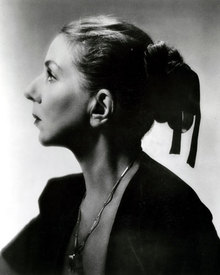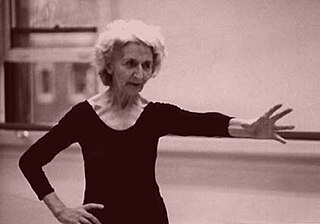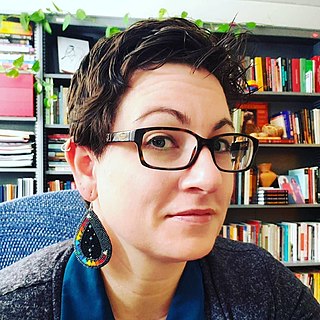
Labanotation is a system for analyzing and recording human movement, invented by Austro-Hungarian choreographer and dance Rudolf von Laban, who developed his notation on movements in the 1920s.
Laban movement analysis (LMA), sometimes Laban/Bartenieff movement analysis, is a method and language for describing, visualizing, interpreting and documenting human movement. It is based on the original work of Rudolf Laban, which was developed and extended by Lisa Ullmann, Irmgard Bartenieff, Warren Lamb and others. LMA draws from multiple fields including anatomy, kinesiology and psychology. It is used by dancers, actors, musicians and athletes; by health professionals such as physical and occupational therapists and psychotherapists; and in anthropology, business consulting and leadership development.

Hanya Holm is known as one of the "Big Four" founders of American modern dance. She was a dancer, choreographer, and above all, a dance educator.

Chief Illiniwek was the mascot of the University of Illinois Urbana–Champaign (UIUC), associated with the university's intercollegiate athletic programs, from October 30, 1926, to February 21, 2007. Chief Illiniwek was portrayed by a student to represent the Illiniwek, the state's namesake, although the regalia worn was from the Sioux. The student portraying Chief Illiniwek performed during halftime of Illinois football and basketball games, as well as during women's volleyball matches.

Katherine Mary Dunham was an American dancer, choreographer, anthropologist, and social activist. Dunham had one of the most successful dance careers of the 20th century, and directed her own dance company for many years. She has been called the "matriarch and queen mother of black dance."

African-American dance has developed within various spaces throughout African-American communities in the United States, rather than studios, schools, or companies. These dances are usually centered on folk and social dance practice, though performance dance often supplies complementary aspects to this. Placing great value on improvisation, these dances are characterized by ongoing change and development. There are a number of notable African-American modern dance companies using African-American cultural dance as an inspiration, among these are the Whitey's Lindy Hoppers, Alvin Ailey American Dance Theater, Dance Theatre of Harlem,and Katherine Dunham Company. Hollywood and Broadway have also provided opportunities for African-American artists to share their work and for the public to support them.

Doris Adelaide Derby was an American activist, documentary photographer, and director of Georgia State University's Office of African-American Student Services and Programs and adjunct associate professor of anthropology. She was active in the Mississippi civil rights movement, and her work discusses the themes of race and African-American identity. She was a working member of the Student Nonviolent Coordinating Committee (SNCC), as well as co-founder of the Free Southern Theater, and the founding director of the Office of African-American Student Services and Programs. Her photography has been exhibited internationally. Two of her photographs were published in Hands on the Freedom Plow: Personal Accounts by Women in SNCC, to which she also contributed an essay about her experiences in the Mississippi civil rights movement.
Bride service has traditionally been portrayed in the anthropological literature as the service rendered by the bridegroom to a bride's family as a bride price or part of one. Bride service and bride wealth models frame anthropological discussions of kinship in many regions of the world.

Ethnochoreology is the study of dance through the application of a number of disciplines such as anthropology, musicology, ethnomusicology, and ethnography. The word itself is relatively recent and etymologically means “the study of ethnic dance”, though this is not exclusive of research on more formalized dance forms, such as classical ballet, for example. Thus, ethnochoreology reflects the relatively recent attempt to apply academic thought to why people dance and what it means.

Ann Hutchinson Guest was an American authority on dance notation and movement analysis, long based in the United Kingdom. She studied more than 80 dance notation systems and translated 20 to Labanotation. This gave her access to a number of dance works in their original version – such as Vaslav Nijinsky's L'Après-midi d'un Faune. Her extensive research, performing and teaching career led her to establish the Language of Dance approach to movement understanding.
Valerie Preston-Dunlop has an MA in movement studies and her PhD in choreography. She is a consultant and Honorary Fellow at London's Trinity Laban Conservatoire of Music and Dance. She conducted extensive research in the life and work of Rudolf Laban. She has written many books and directed DVDs that have contributed to the field of dance. She is a teacher, researcher, and dance scholar.
Eve Gentry was a modern dancer, and later a Pilates master instructor. She was an original disciple of Joseph Pilates, and a master teacher of his technique to generations of instructors. She helped found the Dance Notation Bureau in New York City and later in 1991 she co-founded the Institute for the Pilates Method in Santa Fe, New Mexico.

Antonia Darder is a Puerto Rican and American scholar, artist, poet and activist. She holds the Leavey Presidential Endowed Chair in Ethics and Moral Leadership in the School of Education at Loyola Marymount University. She also is Professor Emerita of Educational Policy, Organization, and Leadership at the University of Illinois at Urbana-Champaign.
Laban Notation Symbols generally refers to the wide range of notation symbols developing from the original work of Rudolf Laban and used in many different types of Laban Movement Study such as Labanotation and Laban Movement Analysis for graphically representing human body positions and movements.
Virginia Dominguez is a political and legal anthropologist. She is currently the Edward William and Jane Marr Gutgsell Professor of Anthropology at the University of Illinois at Urbana-Champaign.
The Laban/Bartenieff Institute of Movement Studies (LIMS) in New York was founded in 1978 as a center for the development and study of the principles of Laban Movement Analysis, formulated by Rudolf Laban and further developed by his student and colleague Irmgard Bartenieff. The institute maintains a library and media resource center that includes published and unpublished text, films and photographs on the subject of Laban Movement Analysis.

Irmgard Bartenieff was a dance theorist, dancer, choreographer, physical therapist, and a leading pioneer of dance therapy. A student of Rudolf Laban, she pursued cross-cultural dance analysis, and generated a new vision of possibilities for human movement and movement training. From her experiences applying Laban’s concepts of dynamism, three-dimensional movement and mobilization to the rehabilitation of people affected by polio in the 1940s, she went on to develop her own set of movement methods and exercises, known as Bartenieff Fundamentals.

Jenny L. Davis is an American linguist, anthropologist, and poet. She is an Associate Professor of Anthropology, American Indian Studies, and Gender & Women's Studies at the University of Illinois at Urbana–Champaign where she is the director of the American Indian Studies Program. Her research is on contemporary Indigenous languages and identity, focusing on Indigenous language revitalization and Indigenous gender and sexuality, especially within the Two-Spirit movement.
Valerie Hoffman is an academic scholar on Islamic studies expertise on religion, anthropology of Islam and Ibadi studies.
Dr. Faye Venetia Harrison is an American anthropologist. Her research interests include political economy, power, diaspora, human rights, and the intersections of race, gender, and class. She is currently Professor of African American Studies and Anthropology at the University of Illinois at Urbana-Champaign. She formerly served as Joint Professor of Anthropology and African American Studies at the University of Florida. Harrison received her BA in Anthropology in 1974 from Brown University, and her MA and PhD in Anthropology from Stanford University in 1977 and 1982, respectively. She has conducted research in the US, UK, and Jamaica. Her scholarly interests have also taken her to Cuba, South Africa, and Japan.










